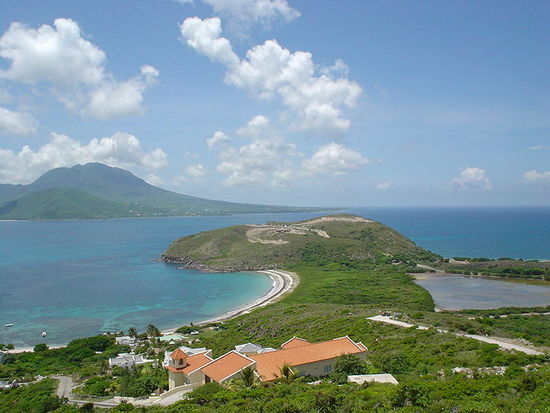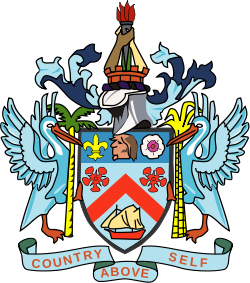Saint Kitts and Nevis' Second National Communication
Project Overview
In Saint Kitts and Nevis water resources are vulnerable to sea level rise and temperature increase leading to higher evaporation rates. Given the centrality of ground water sources to the national water supply, the problem of water resources is primarily one of keeping and protecting the underground water resources. Adaptation measures would include the following actions: rational use of available water enforced by the national water authority; controlled rate of pumping from aquifers; conservation of protective forests that allows a high rate of infiltration of rainfall to the aquifers; and protection against contamination of underground water from pollution sources - agricultural, human settlements and others.
The creation of a National Communication offers countries the opportunity to contribute with technically sound studies and information that can be used for designing mitigation and adaptation measures, and project proposals that can and will help increase their resilience to the impacts of climate change. Activities generally include: V&A assessments, Greenhouse Gas Inventory preparation, Mitigation Analysis or Education, and awareness raising activities. The ultimate goal is the integration of climate change considerations into relevant social, economic and environmental policies and actions.
Project Details
The twin island Federation of St. Kitts and Nevis consists of two islands located in the northern part of the Lesser Antilles chain of islands in the Eastern Caribbean. The larger of the two islands, St. Kitts is 176 sq. km. (68 sq. mi.) in area. It is approximately 36.8 km (23 mi) long and is roughly oval in shape with a narrow neck of land extending like a handle from the southeastern end. Nevis has an area of 93 sq. km. (36 sq. mi), with a length of 12.3 km (7.64 mi) and a width of 9.6 km (5.96 mi) at its widest point.
The islands are the summits of a submerged mountain range along the eastern boundary of the Caribbean Tectonic Plate (MOE, 2000). Although once reliant on sugar monoculture, this industry was closed in 2005. The islands still carry on small scale production of crops, including rice, yams, bananas and cotton, but its present economy is based primarily on tourism (USDS, 2010). The majority of the islands’ inhabitants live near the coastline, as the interior tends to be extremely rugged and steep. However, pressure for agricultural land has caused small farmers to clear forested plots along slopes for farming, causing deforestation, soil erosion and water pollution (MOE, 2000). The country has a high literacy rate at 97.8 per cent and a low unemployment rate of 5.1 per cent. Per capita Gross Domestic Product in 2006 was US$8,546 (USDS, 2010).
In Saint Kitts and Nevis water resources are vulnerable to sea level rise and temperature increase leading to higher evaporation rates. Given the centrality of ground water sources to the national water supply, the problem of water resources is primarily one of keeping and protecting the underground water resources. Adaptation measures would include the following actions: Rational use of available water enforced by the national water authority; Controlled rate of pumping from aquifers; Conservation of protective forests that allows a high rate of infiltration of rainfall to the aquifers; and Protection against contamination of underground water from pollution sources - agricultural, human settlements and others. The use of measures for minimizing runoff of freshwater to the ocean environment would have to be done in agreement with the requirements of the coastal ecosystems, which thrive on definite levels of salinity and organic sediments from land areas.
Adaptation options for the tourism sector include: Developing and enforcing environmental policies and regulations (including building regulations) for tourism activities that take into account the issues of sea level rise and climate change; Ensuring that the risks associated with sea level rise (coastal flooding, increased action of waves and coastal erosion, enhanced storm surges and rising water tables) are taken into consideration in the building and development of new tourism resorts; Redirecting tourism from activities that adversely impact on natural fragile ecosystems, toward more societal activities of historical, traditional and cultural nature that will not be associated with climate change issues.
Adaptation Needs and Priorities
As a coastal developing state Saint Kitts and Nevis is considered to be vulnerable to the effects of climate change. Through its National Communication to the United Nations Framework Convention on Climate Change (UNFCCC) submitted in 2000, the country identifies the following sectors as being particularly vulnerable to the effects of climate change:
- Forestry and terrestrial ecosystems: Climate projections suggest that the islands may experience declining productivity of terrestrial ecosystems, including a possible decrease in forest productivity.
- Coastal ecosystems: The islands’ coasts may be exposed to sea-level rise and other impacts of climate change, including a worsening of present trends of coastal erosion, saline intrusion and sea flooding. These processes could negatively impact natural resources (including coral reefs) and infrastructure.
- Freshwater supply: Given the islands’ dependence on groundwater and anticipated decreases in precipitation in the Caribbean region, water availability on the island may become scarcer and prone to saline intrusion. These impacts would spillover to other sectors of the economy and society, including agriculture, health and tourism.
- Human settlements: Possible intensification of tropical storms may increase damage to tourism structures, homes and other infrastructure.
- Agriculture: Certain climate projections suggest that, with declining precipitation, conditions could become too dry for rain-fed agriculture by the latter half of the twenty-first century. Given that water availability is anticipated to worsen with climate change, this change may impact food security on the islands.
- Tourism: This sector contributes significantly to the islands’ economy and is dependent upon a number of natural and historic attractions, including coastal and marine environments. Climate change may adversely impact the tourism sector through possible sea-level rise, more extreme weather events, decreased water availability, and the declining health of terrestrial ecosystems.
- Human health: Increasing temperatures, declining water quality and other anticipated impacts of climate change may cause a rise in water-borne diseases, as well as have an adverse impact on the nation’s food security and its population’s nutritional status.
The country’s National Communication provides a number of options to address vulnerabilities in the sectors identified above.
National Level Policies and Strategic Documents
Saint Kitts and Nevis has completed a National Communication to the UNFCC and, through its participation in the “Mainstreaming Adaptation to Climate Change” (MACC) project, worked to prepare a national climate change adaptation strategy.
Current Adaptation Action
Currently a low number of discrete adaptation projects are being implemented in Saint Kitts and Nevis, all of which also involve other developing countries. These projects include the island states’ participation in a project funded by the United States Agency for International Development (USAID) that is focused on vulnerability assessment, capacity building, and public awareness in the areas of coastal zones and water, and the recently completed MACC project funded by the Global Environment Facility (GEF) that sought to mainstream climate change adaptation into the policymaking process. Adaptation needs in a variety of sectors are being addressed through these projects, including water, agriculture, tourism, coastal zone management, disaster risk management and the implications of climate change by gender. Most of these projects support capacity building, research, knowledge communication and policy formation and integration.
Proposed Adaptation Action
Saint Kitts and Nevis’ National Communication lists a number of priority actions that could be undertaken to address climate change in the country. Based on available information, it is not clear to what extent these proposed activities have already been undertaken in the country.
Assessment
Saint Kitts and Nevis appears to be addressing adaptation to climate change through participation in a relatively low number of regional projects, and may be in the process of developing a national strategy for climate change. Ongoing activities focus on the country’s articulated adaptation priorities of the water, agriculture and tourism sectors and in coastal areas. Additional action in these sectors and others in which current projects are being implemented, such as the gender dimensions of climate change and disaster risk management, will need to be taken in the future. Noticeably absent in the (limited) suite of current adaptation program occurring in Saint Kitts and Nevis are those addressing vulnerabilities in the areas of forestry, human settlements and human health. As well, a greater focus on implementation of “on the ground” adaptation actions, moving beyond research and capacity building, may be appropriate.
References:
- Medeiros, Hove, Keller, Echeverría, Parry (2011) “Review of Current and Planned Adaptation Action: The Carribean.” Adaptation Partnership / International Institute for Sustainable Development.
- Ministry of Environment [MOE] (2000). St. Kitts and Nevis: Initial National Communication. Retrieved fromhttp://unfccc.int/resource/docs/natc/kitnc1.pdf
- United States Department of State [USDS] (2010). Background Note: Saint Kitts and Nevis. Retrieved fromhttp://www.state.gov/r/pa/ei/bgn/2341.htm
Key Results and Outputs
- Sustainable development and the integration of climate change concerns into medium- and long-term planning
- Inventories of anthropogenic emissions by sources and removals by sinks of greenhouse gases
- Measures contributing to addressing climate change
- Research and systematic observation
- Climate change impacts, adaptation measures and response strategies
- Education, training and public awareness
Monitoring and Evaluation
In 1992, countries joined an international treaty, the United Nations Framework Convention on Climate Change, to cooperatively consider what they could do to limit average global temperature increases and the resulting climate change, and to cope with whatever impacts were, by then, inevitable.
Parties to the Convention must submit national reports on implementation of the Convention to the Conference of the Parties (COP). The required contents of national communications and the timetable for their submission are different for Annex I and non-Annex I Parties. This is in accordance with the principle of "common but differentiated responsibilities" enshrined in the Convention.
The core elements of the national communications for both Annex I and non-Annex I Parties are information on emissions and removals of greenhouse gases (GHGs) and details of the activities a Party has undertaken to implement the Convention. National communications usually contain information on national circumstances, vulnerability assessment, financial resources and transfer of technology, and education, training and public awareness.
Since 1994, governments have invested significant time and resources in the preparation, collection and validation of data on GHG emissions, and the COP has made determined efforts to improve the quality and consistency of the data, which are ensured by established guidelines for reporting. Non-Annex I Parties receive financial and technical assistance in preparing their national communications, facilitated by the UNFCCC secretariat.




